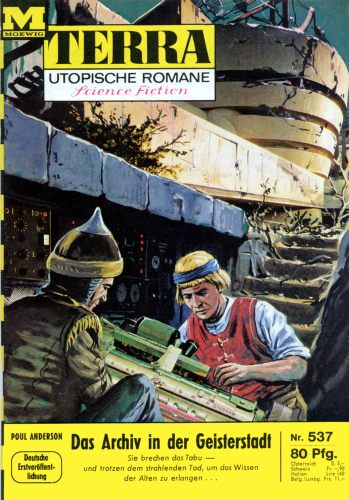Terra SF 537, 08.09.1967
Deutsche Erstausgabe
Originalausgabe 1952
Aus dem Amerikanischen von Birgit Ress-Bohusch
Titelbild : Karl Stephan
Five hundred years after the "Doom" that destroyed present-day civilization and sent nations to their graves with its "glowing death," the world is pictured as a barbaric society composed of primitive tribes that shunned all things connected with the twentieth century.Klappentext der Winston-Erstausgabe
This is the story of sixteen-year-old Carl who set out to break down the ignorant taboos that were destroying a priceless heritage and crushing all hope for the future of humanity.
When the fierce Lann army thundered down from the north to conquer the peace-loving Dalesmen, Carl entered the forbidden City to seek out the wisdom and knowledge that would save his people and rebuild the ancient glories of man. Accused of consorting with witches, threatenened with penalty of death for ignoring the taboo on old-world works and magic, Carl defied his own tribal seer to raise the ban on the time vault which held salvation for a dying civilization. How he fought the invading enemy for life itself in a series of violent clashes, the slow discovery of what twentieth-century civilazation had accomplished makes this book an intriquing one.
With action and suspense and the fascination of science fiction speculation, this tale of rebellion and battle fury is one that will keep readers breathless to the very last page.
Der erste veröffentlichte Roman von Poul Anderson, nachdem er bereits seit 1950 Kurzgeschichten veröffentlichte. Stark auf ein jugendliches Publikum ausgerichtet, erzählt "Vault of the Ages" eine Standardgeschichte, ohne Schnörkel und auch ohne Überraschungen. Liest sich zwar ganz nett, ist aber heutzutage vollkommen überholt. Und es gab bessere Romane mit dieser Thematik, beispielsweise "Daybreak - 2250 A.D." von Andre Norton, ebenfalls 1952 erschienen. Auffallend ist in "Vault of the Ages" der für die 50er charakteristische Chauvinismus, es tritt keine einzige Frau als Handlungsträgerin auf. Doch trotz aller dieser Mängel merkt man schon die Qualität der Andersonschen Schreibe, die dann im folgenden Jahr, 1953, in den Magazin-Versionen dreier großer Romane mündete : Brain Wave, Three Hearts and Three Lions und - last but not least - War of Two Worlds.

Keine Kommentare:
Kommentar veröffentlichen